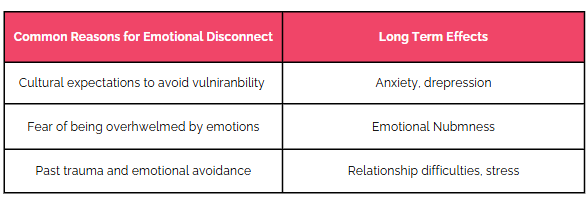November 1, 2024
How to Feel Your Emotions: A Practical Guide to Embracing Emotional Awareness
How to Feel Your Emotions: A Practical Guide to Embracing Emotional Awareness
Growing up, the concept of tuning into my feelings was foreign to me—I didn’t even know it was possible. It simply was something we didn’t discuss. In my family it was important to be strong and not let your emotions get the better of you so I focused on moving forward, keeping my head down, and doing what needed to be done. It wasn’t until I grew older and started playing competitive golf that I began to understand the incredible power of the mind. The sport demanded more than physical skill; it required mental strength, focus, and resilience. Through this journey, I discovered that my thoughts, feelings, and emotions all played a crucial role in my performance, not just on the course but in life. I would never have thought that my sport would have set me up so well for life.
For the first time, I realized how connected my mind and emotions were. Competitive golf taught me that acknowledging and working with my feelings could actually be a source of strength, not a distraction. Instead of pushing down emotions like frustration, fear, or self-doubt, I began learning how to feel and process them. I witnessed them pulse through my body and I recognized that understanding my emotions allowed me to regain control, to stay centered, and to respond with greater clarity. It was a turning point that led me to start exploring emotional awareness more deeply, both on and off the golf course.
As I embraced this process, I realized that finding purpose and resilience could help me maintain balance and joy even in difficult times. I developed a belief that no one else gets to decide how I feel in life—joy, happiness, and love are ultimately my choices. This perspective became the foundation of how I approach each day, no matter what I’m facing.
Why We Struggle to Feel Our Emotions
The Emotional Disconnect
Feeling our emotions is often one of the hardest things we can do. For many of us, it can seem impossible, even frightening, to confront our feelings head-on. The truth is, most of us aren’t given the tools to manage our emotions effectively; they’re just not part of the “toolbox” we’re handed growing up. Instead, we’re frequently taught to “push through,” to be “strong,” and to avoid showing vulnerability at all costs. Culturally, we’re conditioned to ignore our emotional needs, to keep moving forward without taking the time to process what’s happening within us. I was no different. It felt easier to suppress uncomfortable emotions, especially fear or anger, than to sit with them and risk being overwhelmed.
Yet, I’ve come to understand that the real power lies in allowing ourselves to be present with our emotions. This doesn’t mean simply identifying them or giving them a name; it’s about feeling them fully and intentionally letting them move through us. It’s about tuning into the vibration of those emotions within your body and taking notice of where they live within you.
When we allow ourselves to experience emotions in this way, they’re able to flow through us, processing and resolving naturally. But when we suppress or ignore them, they become “stuck,” lingering unresolved within us and often turning into what we call “emotional baggage.” This unprocessed emotional weight can quietly influence our lives, behaviors, and decisions, often without us even realizing it.
From my late teens, I began to understand the power of emotions, though it wasn’t a straightforward path. I had placed immense pressure on myself to succeed in the sport I loved, unknowingly beginning to destroy the joy it once brought me. This relentless drive to achieve turned into a weight, and over time, I realized it was disconnecting me from what mattered most—the experience and love for the game itself.
Through years of practice and reflection, I learned to release some of those pressures and become more present with my feelings. This shift allowed me to realign with my original passion, not just for the sport but for the process itself. As I tuned into my emotions, I began recognizing how expectations, both self-imposed and external, could shape my experience—often creating stress when left unchecked.
 What I discovered is that once you become aware of this power within you, it changes everything. It’s as if a new lens is opened, one that can’t be closed once you’ve looked through it. This emotional awareness became something like a magic power, one that, once unleashed, has served me in every area of life, well beyond the golf course.
What I discovered is that once you become aware of this power within you, it changes everything. It’s as if a new lens is opened, one that can’t be closed once you’ve looked through it. This emotional awareness became something like a magic power, one that, once unleashed, has served me in every area of life, well beyond the golf course.
Being present with my emotions hasn’t always been easy, but it has allowed me to process and let go of stressors rather than letting them fester. This conscious presence means that emotions don’t get stuck, transforming into unresolved baggage that shapes our lives. Instead, I can allow them to pass through, offering me clarity and the ability to make decisions rooted in authenticity rather than reaction.
Learning to face emotions head-on is a journey of resilience and growth, one that has enabled me to live a fuller, more balanced life. Once we unlock this awareness, it becomes a resource we can draw from every day, helping us move through life with a sense of calm and purpose.

The Importance of Emotional Awareness
Emotions as Guides: Why Feeling is Crucial to Well-being
It took me a long time to realize that emotions aren’t something to fear or avoid; they’re powerful guides. Emotions, whether pleasant or difficult, help us understand our needs, set boundaries, and make decisions that align with our values. Think of emotions as a GPS for your inner life—they help you navigate relationships, work, and your sense of self. When I started paying attention to what I felt, I noticed that I made clearer, healthier decisions.
Studies have shown that emotional awareness leads to better mental health, improved decision-making, and increased emotional resilience. For me, this process has been a guiding light for me. By tuning into my emotions, I’ve become more self-aware and able to honor and be present with the emotions pulsing through me.

Identifying Your Emotions
Recognizing What You Feel
One of the first challenges in developing emotional awareness is simply understanding what we’re feeling. Often, we’re not taught to check in with our emotions or identify them clearly, and over time, labeling emotions like sadness or frustration can feel foreign. A useful starting point is to incorporate emotional check-ins throughout the day. Simple questions like “What am I feeling right now?” or “What signals is my body giving me?” can help us become more attuned to our inner state, especially if we tend to push through emotions without fully acknowledging them.
Expanding our emotional vocabulary is also a powerful tool. Emotions aren’t limited to just “happy,” “sad,” or “angry”—there’s a wide spectrum to explore, each word offering a more specific way to understand what we’re experiencing. By learning nuanced terms such as “disappointed,” “anxious,” “content,” or “hopeful,” we can recognize subtler emotions, which provides a deeper connection to our feelings and helps us respond to them more thoughtfully.
 Practical exercises like journaling can be transformative in this process. Setting aside time to write freely about what’s going on internally, without judgment, creates a space where emotions can be fully expressed and understood. Journaling allows us to see patterns in our thoughts and feelings, bringing clarity and helping us identify the underlying factors behind our emotions. In these moments of reflection, we can move beyond surface reactions and gain insights that promote resilience and personal growth.
Practical exercises like journaling can be transformative in this process. Setting aside time to write freely about what’s going on internally, without judgment, creates a space where emotions can be fully expressed and understood. Journaling allows us to see patterns in our thoughts and feelings, bringing clarity and helping us identify the underlying factors behind our emotions. In these moments of reflection, we can move beyond surface reactions and gain insights that promote resilience and personal growth.
Mindfulness practices are another useful approach. Taking a few moments to pause, breathe, and focus on the present can create a powerful reset, enabling us to engage with our emotions rather than suppressing them. By observing our emotions as they are—without immediately reacting to them—we create room to let them pass through us. This practice can prevent emotions from becoming “stuck,” reducing the tendency to carry unresolved feelings forward as emotional baggage.
Building emotional awareness is a gradual journey, and these tools are there to support each step. As we develop these practices, emotional awareness becomes less of a challenge and more of a reliable guide, helping us to navigate life with greater clarity and purpose.

Allowing Yourself to Feel
Embracing the Discomfort: The Process of Feeling
Learning how to feel your emotions isn’t always comfortable. For me, allowing myself to feel emotions like fear or sadness was terrifying at first. I had always been afraid that if I let myself feel too deeply, I might lose control or become overwhelmed. But avoiding emotions only bottled them up, making things worse over time. The real growth happened when I started sitting with these feelings and embracing the discomfort.
One of the most helpful strategies for me was to remind myself that emotions are temporary. They come and go, like waves. By practicing deep breathing techniques and grounding exercises, I found ways to stay present with my emotions without letting them consume me.

The 3-Step Process to Fully Feel Your Emotions
How to Feel Your Feelings in Three Simple Steps
Over time, I adopted a simple, 3-step process to help me feel my emotions fully without getting stuck. Here’s what worked for me:
- Pause and Identify – Whenever I feel overwhelmed, I pause and name the emotion I’m experiencing. It could be fear, sadness, anger, or joy, but identifying it is the first step in understanding it.
- Allow and Accept – Once I identify the emotion, I sit with it. Instead of trying to push it away or change it, I allow myself to feel it fully, knowing it’s temporary. Sometimes this involves deep breathing or mindfulness to stay present.
- Process and Release – Finally, I find a healthy way to process and release the emotion. Journaling, talking to a friend, or even moving my body helps me express and release what I’m feeling.
- Brach, T. (n.d.). RAIN: Recognize, Allow, Investigate, Nurture. Retrieved from https://www.tarabrach.com/rain/
- Hayes, S. C. (n.d.). Acceptance and Commitment Therapy Techniques. Retrieved from https://www.sondermind.com/resources/articles-and-content/act-acceptance-and-commitment-therapy-techniques/
- Noll, D. E. (n.d.). Emotional Mastery Steps. Retrieved from https://dougnoll.com/emotional-competency/emotional-mastery-steps/
For example, after the heartbreaking loss of my 14-year-old daughter, Jenna, I often found myself overwhelmed by a wave of emotions that seemed impossible to navigate. One day, in the midst of deep sorrow, I felt a profound mix of sadness, anger, and helplessness all at once. Instead of trying to push these feelings away, I paused to recognize and name each emotion. I allowed myself to sit with them, acknowledging the depth of my grief without judgment. Afterward, I took a quiet walk, reflecting on Jenna’s memory and the love that remains. By the time I returned, I found that while the pain was still present, my heart felt a bit lighter, and I felt more connected to my emotions and my journey through healing. Ultimately, I felt like I had more choice in how I wanted to move forward with these emotions.
Emotional Regulation and Moving Forward

Finding Balance: Feeling vs. Overwhelm
As I began embracing my emotions, I also learned the importance of emotional regulation. It’s one thing to feel your emotions; it’s another to ensure you’re not consumed by them. Emotional regulation doesn’t mean avoiding or suppressing emotions; rather, it’s about managing them in a way that allows you to stay grounded.
Self-soothing techniques like deep breathing, meditation, journaling, or engaging in a favorite activity helped me balance feeling without becoming overwhelmed. My grief couselor also played a crucial role, providing me with tools to regulate my emotions and keep them from taking over my life.
When You’re Stuck: Dealing with Emotional Numbness
Breaking Through Emotional Blockades
There may be times when you feel emotionally numb—not sad, angry, or happy, but simply detached or disconnected. This numbness is often a natural response to long-term emotional avoidance and can be difficult to work through. To begin reconnecting, consider trying activities that gently encourage self-awareness and presence.
Exploring forms of expression, like art or journaling, engaging in physical movement, or speaking with a counselor are all ways to help reconnect with yourself. By tuning into your body—whether through exercise, mindfulness, or simply taking a few moments to breathe—you may find that life begins to feel more vivid again. Overcoming numbness takes patience and compassion, but as you lean into these practices, you may gradually find yourself opening back up to the full range of emotions once more.
OUR MISSION
We are a nonprofit founded in honor of Jenna Betti, funding programs to empower and inspire people to thrive despite adversity.
Need Support Now?


